Phishing-as-a-service operation uses DNS-over-HTTPS for evasion – BleepingComputer
Published on: 2025-03-28
Intelligence Report: Phishing-as-a-service operation uses DNS-over-HTTPS for evasion – BleepingComputer
1. BLUF (Bottom Line Up Front)
A newly discovered phishing-as-a-service (PhaaS) operation, identified as Morph Meerkat, employs DNS-over-HTTPS (DoH) to evade detection. This operation leverages DNS and email exchange (MX) records to dynamically serve spoofed login pages, targeting users of major email providers. The platform’s advanced techniques and minimal technical requirements pose significant threats to cybersecurity.
2. Detailed Analysis
The following structured analytic techniques have been applied for this analysis:
General Analysis
Morph Meerkat is a large-scale phishing operation that utilizes a complete toolkit to launch effective and scalable attacks. The operation’s infrastructure includes centralized SMTP services to distribute spam emails, often impersonating well-known brands such as Gmail, Outlook, and Yahoo. The phishing emails are crafted to prompt urgent actions, increasing the likelihood of user interaction. The use of DoH allows the operation to bypass traditional DNS monitoring, making detection challenging.
3. Implications and Strategic Risks
The use of advanced evasion techniques by Morph Meerkat presents significant risks to cybersecurity. The operation’s ability to dynamically serve phishing kits based on MX records increases the threat to email users globally. This poses risks to national security, as compromised accounts could be used for further attacks. Additionally, the economic impact could be substantial, with potential losses from fraud and data breaches affecting businesses and individuals.
4. Recommendations and Outlook
Recommendations:
- Enhance DNS monitoring capabilities to detect and block DoH-based evasion techniques.
- Implement stricter email filtering and authentication protocols to reduce phishing email delivery.
- Encourage organizations to educate users on recognizing phishing attempts and reporting suspicious activities.
Outlook:
In the best-case scenario, increased awareness and improved security measures could significantly reduce the effectiveness of Morph Meerkat’s operations. In the worst-case scenario, the operation could expand, leading to widespread data breaches and financial losses. The most likely outcome is a continued cat-and-mouse game between cybersecurity efforts and evolving phishing tactics.
5. Key Individuals and Entities
The report mentions significant individuals and organizations involved in the discovery and analysis of Morph Meerkat. Notable entities include Infoblox and Google, which play roles in monitoring and mitigating the operation’s impact.





